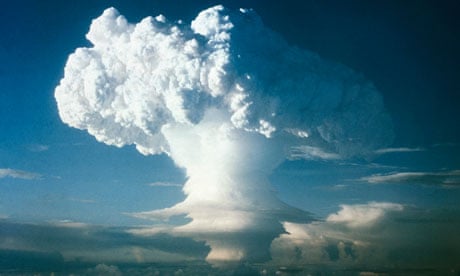On 16 July 1945 an ominous new type of cloud formed over the desert near Socorro, New Mexico. It was created by the first atomic test, and more than the brilliant fireball and tremendous blast, it was this mushroom cloud which became the symbol of the atomic age.
However, mushroom clouds are not unique to atomic explosions. Any sufficiently powerful source of heat, such as a volcano or forest fire can produce one. The heat creates a powerful updraught, channelling dust and smoke from the ground into a narrow chimney, forming the stalk of the mushroom. This chimney continues to rise until it meets an obstruction in the form of a boundary layer in the atmosphere. The rising column then spreads out and forms the cap of the mushroom.
The boundary layer, the tropopause, typically occurs at 30,000 to 50,000 feet, where air stops getting cooler with height and starts getting warmer. The tropopause is also the ceiling for flat-topped cumulonimbus, the anvil-shaped clouds often associated with storms. Forest fires may produce clouds of actual water vapour, known as pyrocumulus, but atomic mushroom clouds are mainly composed of smoke and dust.
Many witnesses described the Trinity cloud as mushroom-shaped, but other terms were also used. Accounts like one in Time magazine of 1960 called them "cauliflower" clouds, because of the roiling, uneven smoke.

Comments (…)
Sign in or create your Guardian account to join the discussion